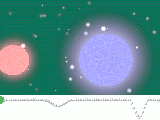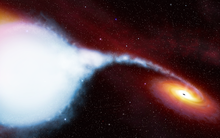Variable star
Variable stars , variable stars or shortly variables are stars that have seen from Earth relatively short-term brightness variations, the cause can not be explained by events in the solar system - such. B. the twinkling of the stars ( scintillation ), which is caused by the unrest in the earth's atmosphere.
Essence
The brightness of variable stars fluctuates with periods which are to be regarded as very short compared to the general stellar evolution. Changes in light can be observed within hours, days, even decades or centuries. There are two different types of variability:
- Intrinsic variability, in which the luminosity of the star changes
- Extrinsic variability, where the luminosity is constant, but the brightness visible from the earth's point of view is variable. An example is eclipse variability , where a star is obscured by a companion.
In the past, variable stars were seen as something special. Nowadays it is assumed that all stars show temporary fluctuations in brightness in the course of their development, because in the last few decades the observation and development of measurement technology have expanded our knowledge of variable stars. As a result, the number of stars on which one can determine brightness variations has increased many times over. With the increase in measurement accuracy, it has become more complicated to find a general definition to differentiate variable stars from unchangeable stars:
- The change in light can be observed in the optical, near ultraviolet or near infrared range.
- The photometrically measurable amplitudes have been refined in the last 100 years from around 0.05 mag to 0.0001 mag in satellite measurements, which relativizes the demarcation of "unchangeable" stars.
history
Antiquity
The first descriptions of the changeable can be found in Chinese chronicles . The new stars were either novae or supernovae . However, it could also have been comets or planetary constellations. According to the Aristotelian view of the world , the sky was eternal and all changes were manifestations of the atmosphere. There are therefore no reports of variable stars from ancient times . It was not until the beginning of the Renaissance that the changeable stars were perceived.
Renaissance
The first variable observed was Mira ("the miraculous"), first described in 1596 by David Fabricius . The cycle-like light change of the Mira star, which is temporarily visible to the naked eye, with a period of 11 months and an amplitude of 8 mag was first described in 1639 by Johann Holwarda . This was the first known variable besides the guest stars (Novae or Supernovae). As early as 1572, Tycho Brahe had proven, based on the immeasurably small parallax of the supernova of the year, that the guest stars are not phenomena of the atmosphere. However, novae and supernovae were not counted among the changeable until the beginning of the 20th century.
The visual era
Mira has long been regarded as one time - until the discovery of the variability of Algol by Geminiano Montanari in 1669. By 1844 only 21 variable stars were known, which had been found by chance either, or in the search for asteroids were discovered. In the same year Friedrich Wilhelm August Argelander published his "Request to the Friends of Astronomy", which can probably be seen as an impetus for the systematic discovery and observation of variable stars.
As a result of the Bonn survey , a star atlas for telescopic stars was available for the first time in the second half of the 19th century ; that is, stars that are invisible to the naked eye. By comparing the starry sky in the telescope with the Bonn survey, numerous variables of great amplitude have been discovered. The determination of brightness was achieved by estimating the variable against constant comparison stars. This method achieves an accuracy of at best 0.3 mag and is subject to subjective influences. Amateur astronomers continue to observe this method to this day and its combined long-term light curves over a range of more than 100 years are of great value in research.
Introduction of photographic processes
When, after 1880, the sensitivity of photographic plates made it possible to record stars, this ushered in a new era in the study of variable stars. A photographic plate stores the brightness of thousands of stars for later investigation and facilitates discovery. Two plates of the same region of the sky are flashed : The images are arranged so that the stars overlap and one or the other plate is shown alternately with the help of a shutter. Variable stars show up by blinking. This is how most variables were found until around 1990. Variables with amplitudes of less than 0.3 mag can be discovered, which also corresponds to the accuracy of the brightness measurements. The period-luminosity relationship of the Cepheids , which is important for astronomical distance measurement , was first described by Henrietta Swan Leavitt in 1912 during an investigation of the variables in the magellanic clouds . However, it was not initially possible to calibrate this relationship.
The 20th century
New and improved observation techniques, together with the further development of theoretical physics, have made it possible to understand the causes of changes in brightness of variable stars in the context of astrophysics .
- The Star spectroscopy has the measurement of radial velocity changes , temperature , surface accelerations of stellar magnetic fields made and the chemical composition of stars possible. The assumption from 1784 that Algol is an eclipse variable could only be proven by measuring the radial velocity curve.
- The photoelectric photometry began shortly after the discovery of the photoelectric effect and thus could the accuracy of the measured brightness to initially 0.01 may be increased. After the Second World War, the measurement accuracy could even be improved to a few millimag through lower- noise amplifiers , larger telescopes and more stable power supply . At the same time, the integration time could be reduced to a fraction of a second, which led to the discovery of very fast phenomena such as flickering during accretion processes .
- The observation of stars outside of the visual realm has contributed a lot to the understanding of variable stars and only sparked interest in new star classes. The satellite-based measurements in the area of gamma radiation , X-rays , ultraviolet radiation as well as infrared radiation and microwave radiation should be mentioned here . Only the near infrared and radio waves and the visual range can be observed from the surface of the earth.
- With the help of the simulation of stars in computers, star models and their development could be tested and continuously improved.
The 21st century
In this century, the trends that have already been indicated in the last decades of the last century have continued so far.
- With a few exceptions, CCD sensors have replaced photoelectric photometry and photographic technology. Since the brightness of hundreds to thousands of stars is already available as digital data with the help of CCDs, the discovery and classification of variable stars is automatic. The OGLE project alone discovered more than 80,000 new variables in or in the direction of the Magellanic Clouds .
- The increase in computer performance enables the transition from 2D to 3D simulations. Many dynamic processes such as supernova outbreaks, pulsations of red giants and stellar magnetic fields produce different results in 3D simulations than in the calculations of 2D sections.
- The satellite-based observations have increased the accuracy of the brightness measurements in the range of a few 0.0001 mag. This has led to the discovery of extrasolar planetary transits and, using asteroseismology, enabled deeper insights into the structure of stars. Furthermore, z. B. the Hubble Space Telescope brought a significant increase in sensitivity and angular resolution . For the first time, a jet from a T-Tauri star could be imaged next to the accretion disk causing it.
- The expansion of observation technology to detect variable stars is no longer based solely on electromagnetic radiation. Nowadays work is being carried out on improving the detection sensitivity in the field of neutrino astronomy and high-energy particles emitted directly from the stars.
- The digitization of the record collections z. B. as part of the DASCH project at the Harvard-Smithsonian Center for Astrophysics leads to the discovery of slow and rare changes in brightness.
designation
The naming of variable stars in the general galactic field is a combination of an identifier and the constellation . After the catalog of Johann Bayer letters have already been used to Q, the first variable was the identifier R. An example is the first variable in the constellation shield , which is named R Scuti. After arriving at Z, followed by RR, RS… RZ and SS, ST to SZ etc., to ZZ. When this namespace was exhausted, AA through AZ etc., up to QZ were used. (J was omitted to avoid confusion with I). Then the number V335 was started and counted for each constellation.
Variable stars of the Milky Way are listed in the General Catalog of Variable Stars and this is a little over 50,000 as of the end of 2016. In addition, the GCVS lists 10,000 variables in other galaxies, as well as over 10,000 "suspected" variables. These two attachments are no longer updated. It is unclear whether the naming will be continued. The artificial satellite Gaia is expected to discover approximately 18 million new variable stars in the Milky Way.
meaning
Variable stars are interesting for astrophysics in many ways:
- Variable stars are the basis for the distance measurement inside and outside the Milky Way over the period-luminosity relationship with pulsating variable , and by the identical maximum brightness of all supernovae of type Ia.
- The asteroseismology of pulsating variables enables an insight into the inner structure by analyzing the vibrations in a star .
- In the case of double-period pulsation variables, the star's mass can be calculated. Otherwise this can only happen in binary star systems . There, however, the structure of the stars can differ from that of a single star due to previous mass transfer.
- In the case of eclipsing stars , a resolution of the star surface is achieved by analyzing the change in brightness when one star covers a second.
- In the case of periodic variables, the smallest changes in the star structure can be found, since these changes add up and are therefore easier to detect than with a direct measurement.
- No classification requires less effort than measuring brightness. Therefore variable stars are used for stellar statistical studies when the stars are too faint for the recording of spectra .
classification
There are several classifications of variable stars, many of which are based on the determination of the amplitude, periodicity, and shape of the light curve . Furthermore, spectral properties and, depending on the type, the behavior in the event of outbreaks are taken into account. The groupings from the General Catalog of Variable Stars (GCVS) are listed below. The AAVSO Variable Star Index (VSX) contains the same groupings, but divides some subgroups ("star classes") differently.
With Gaia DR3 , a new catalog is expected in 2021 with a significantly higher number of variable stars.
Coverage variable
Eclipsing stars can be observed when the components of a binary star system run past one another from the point of view of the earth and thereby cover one another. When a star is covered, the brightness of both star disks is no longer visible from Earth and we observe a minimum. Eclipse-changing stars have probably been known as changeable since ancient times, at the latest since the 17th century. The best-known example is the star Algol - the subgroup of the Algol stars is named after it. Stars in which an exoplanet has been discovered using the transit method are also included in the eclipsing variables.
Rotationally
Rotationally variable stars are stars that change their brightness in the course of their rotation. This happens either because they are ellipsoidally deformed as components of close binary stars or because they show a non-uniform distribution of brightness on the star's surface. A non-uniform brightness distribution can be caused by sunspots or by thermal or chemical inhomogeneities caused by a magnetic field that does not coincide with the axis of rotation . Pulsars , among others, are counted among the variable rotation stars .
Pulsation variable

Pulsating variables show a periodic contraction or expansion of their surface. The radial or non-radial oscillation leads to a change in luminosity due to the change in the radius, the star shape and / or the surface temperature . There are a number of different types of pulsation variators. Some of them play an important role in the measurement of cosmic distances due to the period-luminosity relationship and their high absolute brightness . These include in particular the Cepheids and the RR Lyrae stars . Many pulsation-variable stars are giant stars and so the relatively common Mira stars also belong to this group. Many pulsation-variable stars are located in the Hertzsprung-Russel diagram near the instability strip .
Cataclysmic Mutable
Cataclysmic variables are stars with outbursts of brightness, the cause of which lies in thermonuclear reactions on the surface or in the star's interior. The outbreaks can also have their cause in an accretion disk . Most cataclysmic variables consist of a white dwarf that receives matter from a companion through an accretion disk. This definition of cataclysmic variables differs from that otherwise used in the literature. Astronomical events such as novae and supernovae are also counted among the cataclysmic variables .
Eruptive mutable

The changes in brightness of the eruptive variables are based on flares, envelope eruptions or mass discharges in the form of stellar winds and / or interaction with the interstellar medium . The eruptive variable stars include the luminous blue variable (LBV) , the young T-Tauri stars and the flare stars . Many red dwarfs like Proxima Centauri are also flare stars.
X-ray binary stars
X-ray binary stars are binary star systems that emit X-rays. A compact partner receives matter from another star through accretion . As a result, the X-ray binary stars resemble the cataclysmic variables.
See also
- List of variable stars
- List of star classes
- Naming variable stars
- Federal German Working Group for Variable Stars eV
literature
- Cuno Hoffmeister , Gerold Richter , Wolfgang Wenzel : Variable stars . JA Barth Verlag, Leipzig 1990, ISBN 3-335-00224-5 .
- John R. Percy: Understanding Variable Stars . Cambridge University Press, Cambridge 2007, ISBN 978-0-521-23253-1 .
- J. Percy: Variable Stars: A Historical Perspective . In: variable Star Research: An international perspective . Cambridge University Press, Cambridge 1992, ISBN 0-521-40469-X .
Web links
- Federal German Working Group for Changeable Stars eV (BAV)
- British Astronomical Association Variable Star Section (BAAVSS)
- American Association of Variable Star Observers (AAVSO)
- Information Bulletin on Variable Stars (IBVS)
- AAVSO - locating cards
Classifications
Videos
- What are mutable? from the alpha-Centauri television series(approx. 15 minutes). First broadcast on June 8, 2005.
Individual evidence
- ^ The Philosophical Transactions of the Royal Society of London, from Their Commencement in 1665 to the Year 1800. published 1809, p. 456ff (explanation p. 459); Magazine for the latest in physics and natural history. Volume 2, 2nd St., Gotha 1783, pp. 160f ; Astronomical yearbook for the year 1787. Berlin 1784, p. 145
- ^ B. Warner: Cataclysmic variable stars . Cambridge University, Cambridge 1995, ISBN 0-521-54209-X .
- ^ S. Shore, M. Livio, E. van den Heuvel: Interacting Binaries . Springer, Berlin 1994, ISBN 3-540-57014-4 .




